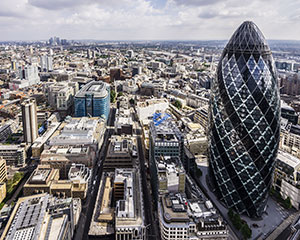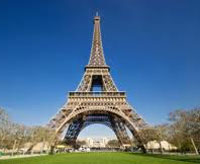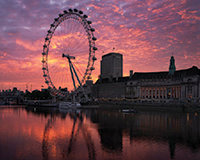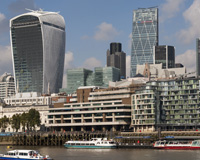
Brand image is becoming increasingly important in determining a building’s commercial value. It is becoming common for the names of famous buildings to be protected by trade mark registrations. For example, the names “London Eye”, “Battersea Power Station” and “The Shard” are all UK or EU registered trade marks.
Some of the newer buildings in London have gained affectionate nicknames and these are also being registered. For example, “The Gherkin” is a registered trade mark, even though the building is officially known as 30 St Mary Axe, EC3. Similarly there is a pending application to register the “The Cheesegrater” as an EU trade mark.
In addition to famous names, the iconic shape of certain buildings has also been protected. There are a number of UK registered trade marks for the shape of the Gherkin and, further afield, there are registered UK or EU trade marks for distinctive buildings including the Portsmouth Spinnaker Tower, the Eiffel Tower, Real Madrid’s Bernabéu stadium, the Dubai International Finance Centre and the Transamerica Pyramid in San Francisco.
But when it comes to the intellectual property of real estate, there are a wide range of potential complications which developers and owners should be aware of if they seek to exploit the commercial value of their building’s very identity.
Copyright
UK copyright may subsist in works of architecture, which include “buildings” or “models for buildings”. As there is no need for formal registration, copyright arises automatically, provided that the work is original, recorded and the result of some effort (all of which have fairly low thresholds).
The architect is generally the owner of any copyright in the plans and the building created by the plans, unless there is an agreement to the contrary or it is created by an employee during the course of their employment, in which case the employer will be the owner. Even if the architect works on a commission basis, the architect will still own the copyright, although there may be an implied licence for the company commissioning the work to use it. If the commissioner of the work wants to own the copyright it is important to discuss this at the outset and ensure that it is assigned by contract.
Copyright in a building or building model or plan lasts for the life of the architect plus 70 years. Accordingly, newer buildings such as The Shard still retain copyright protection. On the other hand, St Paul’s Cathedral, designed by Sir Christopher Wren who died in 1723, has been out of copyright for some time.
Freedom of panorama
It is an infringement of copyright to make another building which copies or incorporates a substantial part of a building (or part of a building) protected by copyright and this is assessed on a qualitative basis. On the other hand, copyright protects the expression and not the idea so general architectural ideas or concepts may be applied and developed without risk of infringement.
In the UK, there is a specific defence to copyright infringement (known as “freedom of panorama”), which allows third parties to take photographs or make films incorporating buildings or other works of artistic craftsmanship that are permanently situated in public places or premises that are open to the public. Similarly, the copyright in the building is not infringed by the making of a broadcast of a visual image of it or the issue to the public of such photographs.

Countries such as France, Greece and Italy currently do not have this defence. This leads to a peculiar situation regarding the Eiffel Tower in Paris. It was built in 1889 so copyright in the building has expired and citizens are free to take photographs of it during the day. However, the lighting system that illuminates the tower at night is newer and a work of art so photographing it still requires permission from the operating company. To resolve this, the French parliament is currently considering the introduction of a limited non-commercial exception for individuals. There are also moves to harmonise the exception across the EU, although there is ongoing debate about whether this will be limited to non-commercial purposes.
Distinctive designs
Certain elements of a building may not qualify for copyright protection but may have sufficient novelty and individual character to be protected as a design. In general, it is a relatively simple and inexpensive process to obtain UK registered design protection or registered EU design protection for the outward appearance of a product (or part of it) provided that the design is not dictated exclusively by its technical function. Registered design protection can offer protection for up to 25 years (subject to renewal every five years) and prevents unauthorised third parties from making or putting on the market products which incorporate the design or a design that does not create a different overall impression. One complication to be aware of if using CAD technical drawings in design applications is that the Supreme Court in the recent case involving Trunki suitcases held that the inherent shading of such drawings can be a critical element of the design (PMS International Group Plc v Magmatic Ltd [2016] UKSC 12).
Unregistered design right might also cover the original three-dimensional shape of a non-artistic building and this protection arises automatically on the creation of the original design (ie one that is not commonplace in the design field at the time of its creation). An unregistered design would allow the owner to prevent others from making articles that are the same or substantially the same as the design or dealing with such articles knowing that they are infringing. Generally, an element of copying is required but this can be inferred if the articles are similar.

Corporate branding
Those frequenting Canary Wharf are used to landmark buildings showcasing brands through neon signs and lighting. However, this is not an entirely new practice – architects have been developing ingenious designs to advertise their products for years. A good example is the OXO Tower, which was rebuilt in 1929 when owned by the manufacturers of OXO beef stock cubes. After permission for an illuminated advertisement was refused, the tower was built with four sets of windows spelling out “OXO”, which are lit at night and create an identifiable piece of branding that’s become something of a local icon. The London Eye also courted controversy and a dispute with Lambeth planning applications committee in 2011 when it painted one of its capsules in the corporate orange colour of its then sponsor, EDF.
Trade marks
Buildings in our city skylines might also be protected by a number of forms of trade mark registration. Such trade mark registrations provide an advantage in preventing the sale of unauthorised merchandise incorporating the building name or shape or cheap miniature replicas that may devalue the overall brand image. A registration on a public trade mark register might in itself deter a potential infringer. However, if necessary, it is generally easier to bring enforcement action based on a registered trade mark than copyright infringement or passing off. This is because you only have to provide proof of the trade mark registration rather than historical evidence of the independent creation/ownership of the design or how a reputation has grown in the building over time. Another advantage is that financial investors place greater value on registered IP rights.
Unfortunately, however, obtaining trade mark registrations for the shape or nickname of buildings is not always an easy task.
Nickname marks
In order to register a building nickname as a trade mark, the applicant must satisfy the usual requirements for registration, for example that the nickname distinguishes the goods and services of one undertaking from those of another.
The most interesting question in relation to the registrability of building nicknames concerns the fair ownership of the marks. The nicknames are generally devised by the general public rather than any company associated with the buildings. Accordingly, is it right that the trade mark applicant might obtain a potential monopoly over the use of the nickname in relation to certain goods and services? Or should the entity that uses the nickname commercially be the trade mark owner because the nickname is not a trade mark until it is used in connection with goods and services on the market? These questions have not been tested by the courts to date.
Shape marks
In general, it is particularly difficult to register and enforce trade marks of three dimensional shapes, and there have been a number of recent UK and EU court cases that illustrate this in different areas:
(i) the shape of the four finger KitKat bar has been held to be devoid of distinctive character;
(ii) the shape of the newer form of Coca-Cola bottle has been refused registration because it does not possess any characteristics that distinguish it from other bottles available on the market;
(iii) UK and EU three-dimensional trade marks representing the shape of London taxis have been held invalid because they were only a variation on the typical shape of a taxi and not an indicator of the origin of goods.
Buildings that have an exclusively functional shape might also be refused registration, or potentially challenged. Could it be argued that the Gherkin’s swirling striped pattern is exclusively the result of the building’s energy-saving air flow system? Is the shape of the Walkie Talkie necessary to maximise the building’s square footage from the footprint?
Buildings as brands
The increasing importance of intellectual property in property development is best described by Kent Gardner, chief executive officer of Evans Randall, previous co-owners of the Gherkin. In his words: “The idea that a building can be a brand is comparatively new but it is one that we as building owners have recognised for some time.
“We believe that the commercial value of a property is determined not merely by its income stream or by capital appreciation. It can also be a function of its brand, its design or its iconic appearance. That is why during our ownership of the Gherkin we trademarked its nickname and distinctive shape.
“As investors we wanted to protect inherent value from potential erosion by inappropriate use of the asset’s name, appearance or any other manifestation of its unique brand.”
Leighton Cassidy is a partner and Beverley Potts is a senior associate (PSL) in the Intellectual Property team at Fieldfisher










